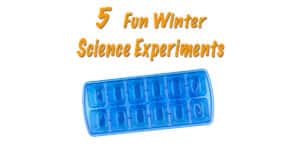
With a couple more weeks left of winter, Long Island families are growing tired of the winter season and gearing up for the warmer months ahead. If you find yourself running out of things to do with your kids that are educational and fun, try the 5 fun winter science experiments listed below.
- Fun Freeze Contest
This is a fun and easy experiment using materials you already have at home. Give your child a clean, dry ice cube tray and explain to them that their job is to act as a scientist and find out how long it takes for different substances to freeze. Together, find several items that you want to test. Some examples are water, salad dressing, juice, milk, etc. Pour a small bit of each in a separate section of the ice cube tray, and develop a hypothesis of which you think will freeze first, and why. Place your tray in the freezer, and wait. Record your findings, and brainstorm with your child to discover why you got the results you did.
- Create Frost at Home
Using a clean, empty metal can, have your child fill it halfway with ice cubes. Then add water and salt. Wait a bit, and you’ll see frost begin to form on the outside of your metal can. The longer you leave the can untouched, the more frost will collect. Discuss with your child why this might happen, and how salt affects the water and ice combination.
- Ice Excavation
This activity works best when prepared the night before. Using disposable paper cups, place small figurines inside and cover with water. Freeze the cups overnight, and remove the paper in the morning. Your child’s job now is to plan the best way to retrieve their figurine from the ice. Allow them to brainstorm and experiment with different methods as you supervise. Encourage them to record their findings, noting what was and was not effective, and why.
- Indoor Ice Fishing
Fill a large cup or bowl with water, and add a few ice cubes. Have your child use a piece of heavy string to try and fish for an ice cube. Discuss with them why this doesn’t work, and then have them place their string on top of the ice cubes. Sprinkle some salt on top, and give it a minute to bond to the ice. Have your child see how many ice cubes he or she can catch, and discuss why the salt causes the string to attract the ice.
- Play in the Snow – Indoors!
On days it’s too cold or not ideal for playing outside, create snow at home and play indoors! Take a large bowl of baking soda, and add water until the baking soda is damp. Ideally, you should be able to pick it up and mold it. Place your “snow” into the freezer for a half hour to forty-five minutes. It’s ready when you can mold it into a snowball, and should feel similar to actual snow! To avoid a snowy mess, allow your child to play with it inside the bathtub.









Leave a Reply
You must be logged in to post a comment.